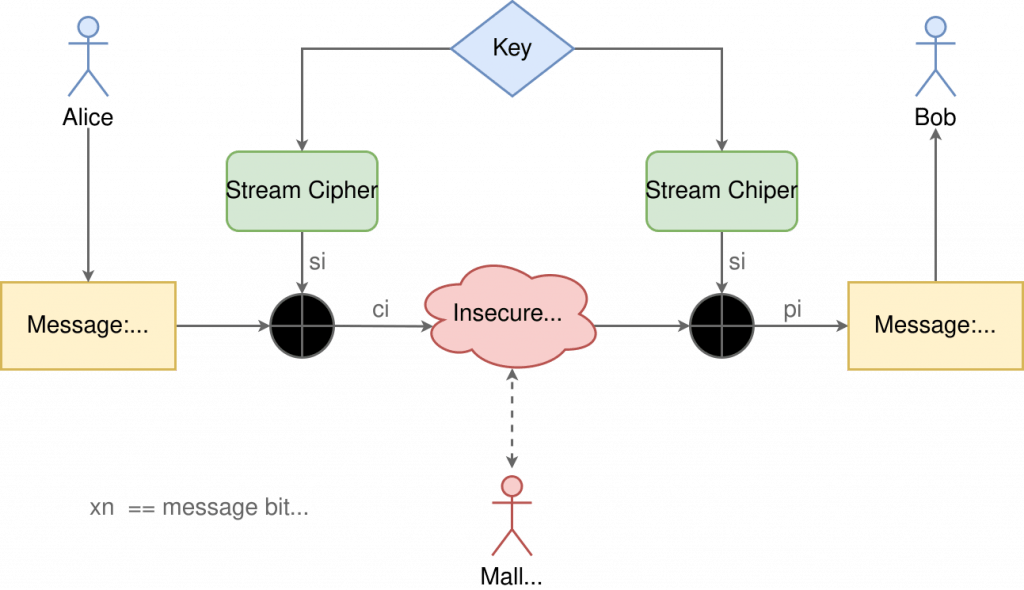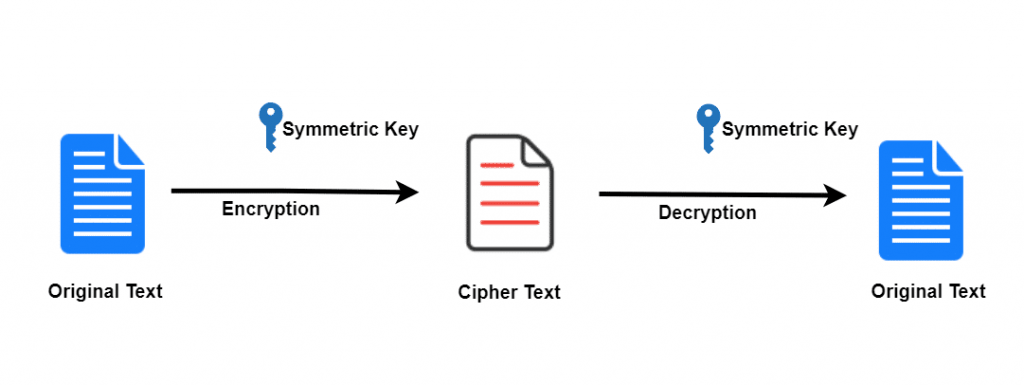
- Introduction to Symmetric Cryptography
- Types of Secret Key Cryptography
- Common Algorithms in Symmetric Cryptography
- Encryption and Decryption Process
- Advantages and Disadvantages of Secret Key Cryptography
- Key Management in Secret Key Cryptography
- Use Cases of Secret Key Cryptography
- Conclusion
Introduction to Symmetric Cryptography
Symmetric cryptography, also known as secret key cryptography, is a type of encryption where the same key is used for both encryption and decryption of the data. In this system, the sender and receiver must possess the same key, which must be kept secret from any third parties. Cybersecurity Training Courses type of encryption ensures that the data transmitted over insecure channels, such as the Internet, remains confidential.Symmetric cryptography is one of the oldest and most widely used forms of encryption. Its simplicity and efficiency make it suitable for protecting large amounts of data. However, one of the main challenges of symmetric cryptography is securely distributing the secret key between the communicating parties.
Are You Interested in Learning More About Cybersecurity? Sign Up For Our Cyber Security Online Training Today!
Types of Secret Key Cryptography
- Stream Ciphers: Stream ciphers encrypt plaintext data one bit or byte at a time. The encryption is done by combining the plaintext with a keystream generated from the secret key. Stream Playfair Cipher are fast and efficient, making them suitable for encrypting real-time audio or video streams. An example of a stream cipher is RC4.
- Block Ciphers: Block ciphers encrypt data in fixed-size blocks, typically 64 or 128 bits at a time. Each block is processed independently, and the same key is applied to each data block. Block ciphers are more commonly used in modern cryptographic systems for their robustness and flexibility. Examples of block ciphers include AES (Advanced Encryption Standard) and DES (Data Encryption Standard).
- Hybrid Ciphers: In some systems, both stream and block ciphers are used in a hybrid approach. For example, a stream cipher might be used to generate a key for a block cipher, combining the strengths of both encryption methods.
- Encryption: The sender takes the plaintext (the original message) and applies an encryption algorithm using the secret key to convert the plaintext into ciphertext. The ciphertext is the unreadable encrypted message to anyone who does not possess the secret key.
- Decryption: The receiver, who possesses the same secret key as the sender, applies the decryption algorithm to the ciphertext reverses the encryption process and converts the ciphertext back into the original plaintext. Only the receiver who has the secret key can decrypt the ciphertext correctly.
- Advantages: Speed and Efficiency in Symmetric cryptography is generally faster and more efficient than asymmetric cryptography, especially when processing large amounts of Database Security. Simple to Implement the Secret key cryptography is relatively straightforward compared to public key systems, requiring only a single key for encryption and decryption. Low Computational Overhead Since symmetric algorithms are typically less computationally intensive than asymmetric algorithms, they are better suited for resource-constrained environments, such as mobile devices or embedded systems.
- Disadvantages: Key Distribution Problem major drawback of symmetric cryptography is the difficulty of securely distributing and managing the secret key. If the key is intercepted during transmission, the entire security of the system is compromised. Scalability Issues in systems with many users, maintaining a secure key for each pair of users becomes increasingly difficult. For n users, n(n-1)/2 keys may be needed, making key management complex in large systems. Lack of Non-repudiation Unlike asymmetric cryptography, Quantum Cryptography does not provide non-repudiation. Since the sender and receiver share the same key, they cannot prove to a third party who sent the message.
- AES (Advanced Encryption Standard): AES is one of the most widely used symmetric encryption algorithms. It is known for its strength and efficiency. AES supports key sizes of 128, 192, and 256 bits, with 128-bit blocks. AES is used in various applications, including securing sensitive government, financial, and enterprise data.
- Key Generation: The secret key must be randomly generated and kept secure. The randomness of the key is crucial to ensuring its strength against brute-force attacks.
- Key Distribution: The secret key must be securely shared between the sender and receiver. This can be done using secure key exchange protocols such as Diffie-Hellman or RSA.
- Key Storage: Secret keys should be stored securely in hardware security modules (HSMs) or encrypted databases to prevent unauthorized access.
- Key Rotation: Regularly rotating the secret key helps mitigate the risk of key compromise. If a key is suspected to be compromised, it should be immediately replaced with a new one.
- Key Expiry: Secret keys should have an expiration date to limit their lifespan. Once a key expires, it should no longer be used, and a new key should be generated and distributed.
- Data Encryption: Symmetric cryptography is commonly used for encrypting large volumes of data, such as files, databases, and network traffic. It is widely used in protocols like SSL/TLS (though SSL/TLS typically uses hybrid encryption, combining both asymmetric and symmetric encryption).
- Disk Encryption: Full disk encryption tools, such as BitLocker and FileVault, use symmetric cryptography to encrypt the data stored on a disk, ensuring that data remains secure even if the physical device is lost or stolen.
- Virtual Private Networks (VPNs): VPN protocols, such as IPSec, rely on symmetric cryptography to secure communications over the Internet Protocol Address, allowing users to establish encrypted connections to private networks remotely.
- Secure Messaging: Applications that offer end-to-end encrypted messaging, such as WhatsApp and Signal, use symmetric cryptography to ensure that messages are only readable by the intended recipients.
- Data Backup and Archiving: Symmetric cryptography is often used to protect backup data from unauthorized access, ensuring that sensitive information remains confidential even if the backup media is lost or stolen.

Want to learn more about Cybersecurity ? Enroll in our Complete Cyber Security Online Training .
Common Algorithms in Symmetric Cryptography
AES (Advanced Encryption Standard) is one of the most widely used symmetric encryption algorithms. It is known for its strength and efficiency. AES supports key sizes of 128, 192, and 256 bits, with 128-bit blocks. AES is used in various applications, including securing sensitive government, financial, and enterprise data. DES (Data Encryption Standard) was once a widely used symmetric encryption standard, but it has been deprecated due to vulnerabilities in its 56-bit key length. Despite its weaknesses, it remains an important historical algorithm in cryptography. 3DES (Triple DES) was developed as a more secure variant of DES by applying the DES algorithm three times with different keys. While stronger than DES, it is still considered less safe than AES, and its use has been phased out in favor of more modern algorithms. RC4 is a stream cipher widely used in Internet Protocol Address like SSL/TLS. However, it is now considered insecure due to vulnerabilities in its design, and it is no longer recommended for use in modern cryptographic systems. Blowfish is a block cipher that operates on 64-bit blocks and supports key sizes ranging from 32 to 448 bits. It is a fast and efficient algorithm, but it is now less popular than AES due to its smaller block size. Twofish is a successor to Blowfish and is a block cipher that operates on 128-bit blocks. It supports key sizes of 128, 192, and 256 bits. While it is not as widely used as AES, it is still considered a strong and secure algorithm.
Encryption and Decryption Process

Advantages and Disadvantages of Secret Key Cryptography
Transform Your Career with Cyber Security Knowledge Enroll in ACTE’s Cyber Security Expert Masters Program Training Course Today!
Key Management in Secret Key Cryptography
Key management is one of the most critical aspects of symmetric cryptography. Since the same key is used for encryption and decryption, it is essential to securely distribute, store, and rotate the key to ensure the integrity and confidentiality of the encrypted data. Key management involves several steps in this Cybersecurity Training Courses:
Preparing for Cyber Security job interviews? Check out our Cyber Security Interview Questions and Answers now!
Use Cases of Secret Key Cryptography
Conclusion
In conclusion, while symmetric cryptography offers a fast and efficient solution for securing data, key management remains its primary challenge. Proper implementation and secure key distribution and rotation practices are essential to ensure the strength and security of symmetric encryption systems. Without proper protection of encryption keys, even the most robust algorithms can be compromised. Additionally, regular updates and the use of advanced key management techniques can help minimize the risks associated with key exposure. As the landscape of cyber threats continues to evolved in Cybersecurity Training , organizations must adopt best practices in symmetric cryptography to safeguard sensitive information and maintain data integrity across communication channels.





